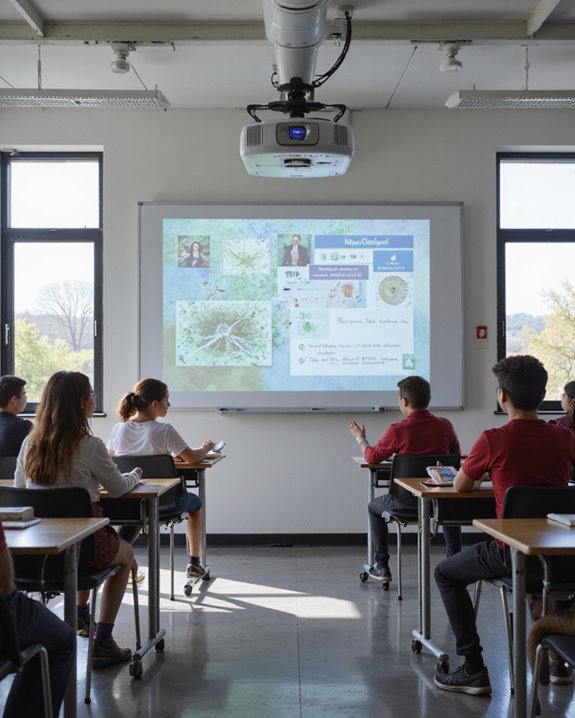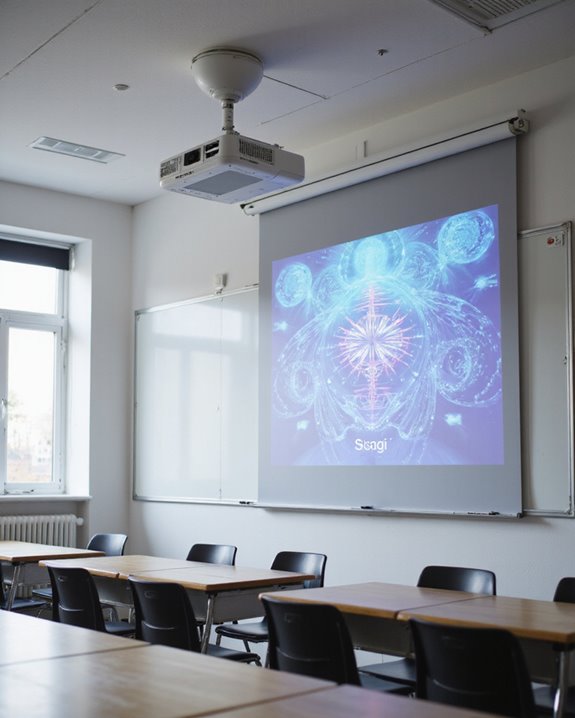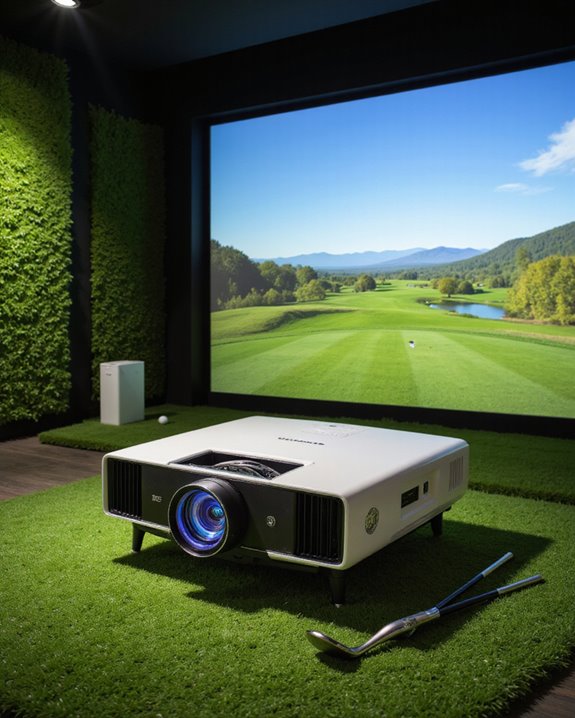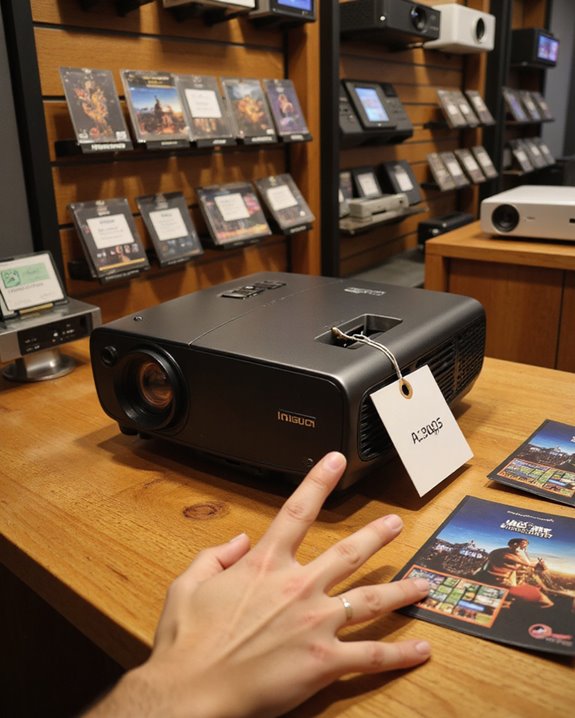Projectors have revolutionized modern classrooms by transforming traditional teaching into interactive, multimedia experiences. These devices enable teachers to display dynamic visual content, including videos, presentations, and 3D models, which helps increase student engagement by up to 70%. Studies show that visual aids supported by projector technology lead to 25% higher test scores and improved retention rates. Enhanced accessibility features support diverse learning needs through captions and assistive technology. The integration of projectors with AI and digital tools continues to reshape educational possibilities.
Key Takeaways
- Projectors enhance visual learning by combining text, images, and videos, leading to 25% higher test scores and improved student engagement.
- Interactive features enable real-time content manipulation and support collaborative learning through multi-touch capabilities for up to 10 students simultaneously.
- Modern projectors facilitate personalized learning through adaptive platforms and provide immediate feedback for student performance assessment.
- Integration with AI and data analytics creates immersive learning environments where students feel 3.75 times more connected.
- Projectors support accessibility in special education through visual aids, captions, and assistive technology integration with IEPs.
The Evolution of Projector Technology in Education
How did the humble classroom projector evolve from its early beginnings to become an essential educational tool? The historical milestones of projection technology in education trace back to the late 1800s, when Kodak’s introduction of celluloid film in 1889 marked the beginning of modern projection methods.
Early educators and entertainers used magic lantern slides to captivate audiences and share visual knowledge. Significant technological innovations followed throughout the 20th century. Filmstrip projectors emerged in the 1920s, allowing teachers to pause presentations for classroom discussions. Overhead projectors, first used for military briefings during World War II, found their way into classrooms by the 1950s. The 1980s brought digital projection panels, enabling computer connectivity and marking an indispensable shift from analog to digital technology. By 1990, integrated computer projectors revolutionized classroom presentations, paving the way for today’s interactive learning environments and the integration of digital connectivity to enhance teaching methods.
Visual Learning and Student Engagement
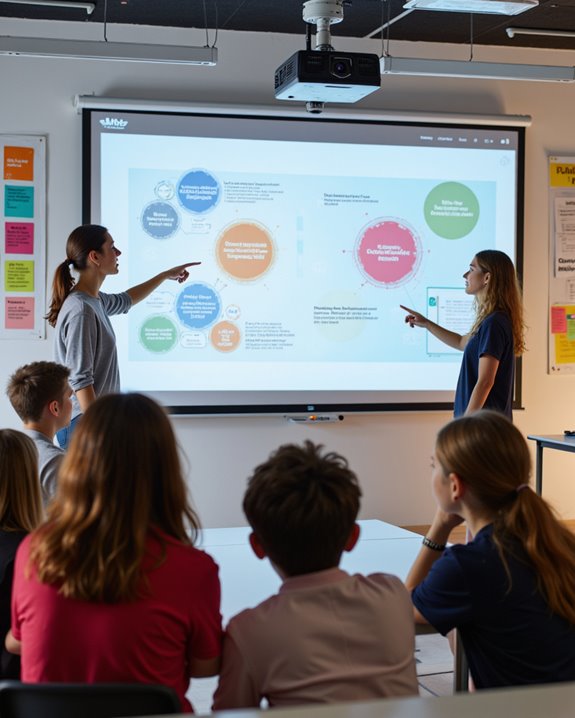
As projection technology found its place in classrooms, research began revealing its profound impact on visual learning and student engagement. Historical context shows that traditional teaching methods often struggled to maintain student interest, but projectors transformed this dynamic. Studies indicate that 75% of educators and students agree visual aids clarify content, while 70% report enhanced motivation. The integration of high-quality projectors has also facilitated interactive learning environments, fostering more dynamic and engaging lessons. Cultural influences across different learning environments demonstrate how projector technology bridges educational gaps through multimedia visualization. The technology’s versatility supports various teaching approaches, leading to 25% higher test scores and improved student satisfaction. Modern interactive projectors now enable up to 10 points of multi-touch capability for enhanced collaboration. Interactive features encourage active participation and collaborative learning, helping students develop critical thinking skills. This shift from passive to engaged learning represents a significant advancement in modern education, particularly in how students retain and process information.
Interactive Features and Collaborative Learning

When interactive projectors entered classrooms, they revolutionized collaborative learning by enabling students to directly manipulate projected content. These systems support real-time group work and encourage active participation, transforming traditional teaching methods into dynamic learning experiences. Through gamification techniques, teachers can create engaging activities that promote critical thinking and problem-solving skills. Interactive technology helps bring complex abstract concepts to life through visual representations and 3D models. Incorporating projection-based interactivity can also enhance student motivation and facilitate diverse learning styles.
The effectiveness of interactive projectors depends heavily on proper teacher training and implementation strategies. Studies show varied results in learning outcomes, with some research indicating improved test scores while others show no significant difference. However, these tools consistently demonstrate benefits in student engagement and knowledge retention. When integrated with other digital technologies, interactive projectors help create all-encompassing learning environments that prepare students for future collaborative work scenarios.
Digital Integration and Modern Teaching Methods
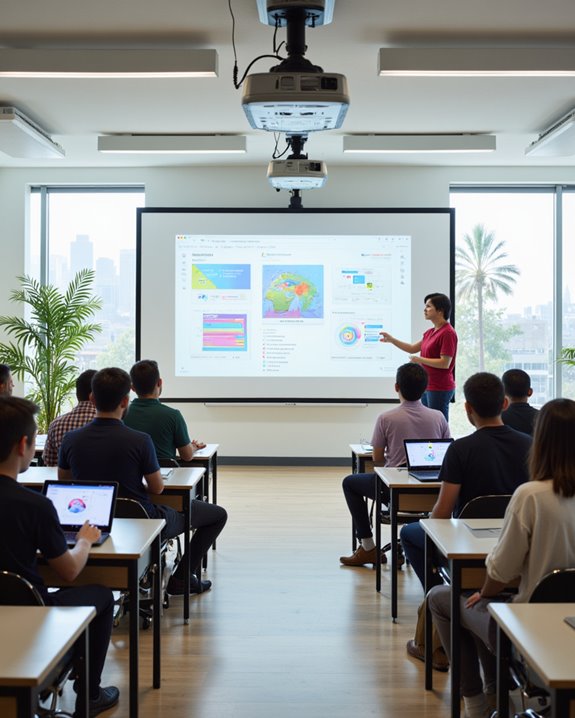
The rapid evolution of digital technology has fundamentally transformed modern teaching methods, creating new possibilities for classroom instruction and student engagement. Schools now integrate digital storytelling and virtual simulations alongside traditional teaching tools, allowing educators to present complex concepts in more accessible ways.
Modern classrooms combine projector technology with adaptive learning platforms, enabling teachers to deliver personalized content that meets diverse learning needs. According to research, 65% of teachers demonstrated the necessary skills to effectively integrate digital devices in OECD countries’ schools. These integrated systems support real-time feedback and collaborative learning experiences, while virtual simulations provide students with hands-on practice in safe, controlled environments. Teachers can now seamlessly switch between different digital resources, incorporating multimedia elements that enhance student understanding. This technological integration requires ongoing professional development for educators, ensuring they can effectively utilize these tools to maximize learning outcomes.
Impact on Student Performance and Retention

Understanding how projector technology affects student success reveals complex and sometimes unexpected results in modern education. Research shows mixed outcomes in learning achievement between interactive and standard projectors, though student motivation consistently improves with interactive systems. Studies report average test scores of 82.40 when using multimedia projectors, with no significant performance differences between genders. A key study demonstrated that students taught with multimedia projector methods significantly outperformed those taught through conventional approaches.
The classroom atmosphere benefits from these technological tools, as they create more engaging learning environments. Students demonstrate higher satisfaction and participation rates when multimedia elements are incorporated into lessons. While direct evidence linking projectors to retention rates remains limited, increased student engagement and participation suggest positive impacts. Interactive features enable immediate feedback and support various learning styles, particularly benefiting visual learners through exhaustive content delivery combining text, images, and video.
Accessibility and Special Education Benefits
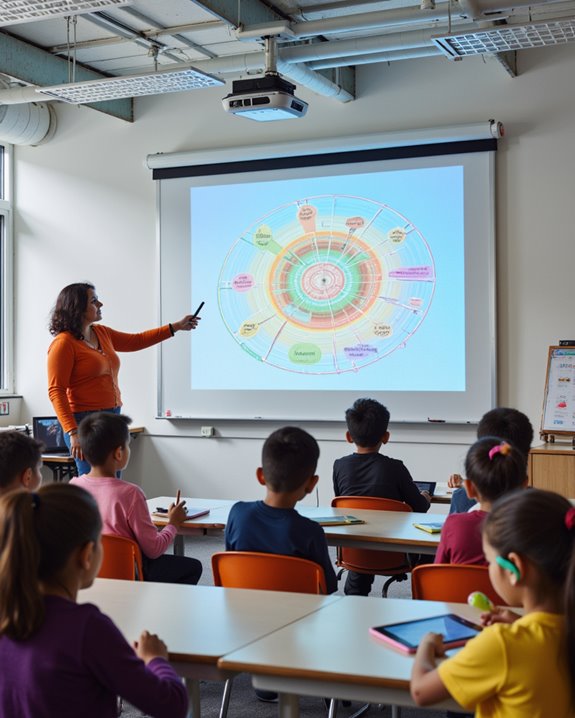
Modern projector technology revolutionizes accessibility in special education classrooms, creating inclusive learning environments for students with diverse needs. Through integration with Assistive Technologies, projectors deliver enhanced visual aids, captions, and text-to-speech capabilities that support students with various disabilities.
These tools facilitate Inclusive Education by enabling teachers to customize content for individual learning requirements. High-definition displays and interactive whiteboards help students with visual impairments access educational materials more effectively. The combination of projectors with multimedia elements creates multisensory learning experiences, benefiting students who respond better to varied teaching methods. Advanced AI systems like Be My AI provide real-time visual assistance through projector displays, helping students better understand and interact with projected content. Integration with specialized software and audio systems further supports the implementation of Individualized Education Plans (IEPs), ensuring that students with disabilities receive appropriate educational support while participating in mainstream classroom activities.
Future Trends and Smart Classroom Implementation

Building upon advances in accessibility technology, smart classroom implementation continues to reshape educational environments through innovative digital solutions. Schools are integrating projectors with artificial intelligence and data analytics to create more engaging learning experiences. Students learning through these immersive tools report feeling 3.75 times more connected than those in traditional classroom settings. While educational funding remains a key concern, institutions are finding cost-effective ways to implement these technologies alongside traditional teaching methods.
Teacher training has become essential as classrooms evolve to include interactive displays and immersive technologies. Modern projectors now support:
- Virtual and augmented reality applications
- Real-time data analytics for student performance
- Cloud-based content sharing
- AI-driven personalized learning
These advancements are transforming traditional classrooms into dynamic learning spaces. As technology costs decrease and capabilities increase, schools are developing strategic plans to incorporate these tools while maintaining educational effectiveness.
Frequently Asked Questions
How Long Do Modern Projector Bulbs Typically Last Before Needing Replacement?
Modern projector bulb lifespan varies considerably: UHP and UHM bulbs last 2,000-4,000 hours, while LED and laser sources can endure 20,000-50,000 hours. Regular maintenance and proper cooling extend operational life before replacement.
What Safety Precautions Should Teachers Take When Mounting Classroom Projectors?
Like a guardian angel, proper installation guidelines safeguard students and staff. Teachers should guarantee secure ceiling mounting, follow electrical safety protocols, manage cables appropriately, and verify weight compatibility with mounting brackets.
Can Projectors Damage Students’ Eyes With Prolonged Exposure?
While projectors typically don’t cause permanent damage, prolonged exposure can lead to eye strain. Students may experience discomfort from screen glare, making proper positioning and regular viewing breaks essential for eye health.
Which Projector Brands Are Most Reliable for Daily Classroom Use?
Epson and BenQ demonstrate superior brand reliability for daily usage in classrooms. Their projectors feature durable construction, long-lasting light sources, and consistent performance. ViewSonic and Samsung also maintain strong reputations for educational applications.
How Can Teachers Prevent Shadows When Writing on Projected Content?
For exceptional shadow prevention and writing clarity, teachers should brilliantly position projectors at elevated angles, utilize multiple light sources, adjust room lighting strategically, and employ digital pointers instead of physical ones during presentations.

